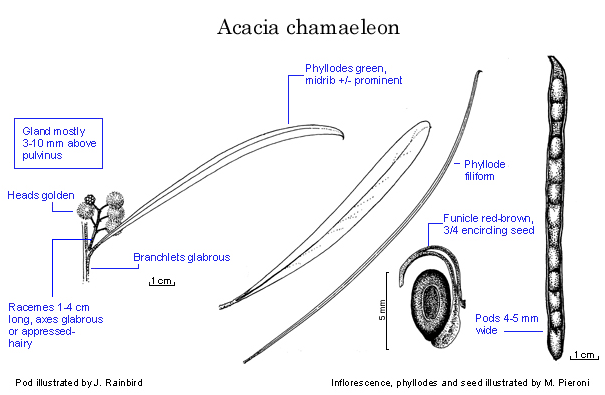Acacia chamaeleon Maslin
WATTLE
Acacias of Australia
Family
Fabaceae
Distribution
Confined to a small area bounded by Broomehill, Nyabing (c. 60 km NE of Broomehill) and Jerramungup, south-western W.A.
Description
Openly crowned, glabrous shrub 2–3 m high. Branchlets finely ribbed. Phyllodes subdistant, variable, narrowly linear to filiform or oblanceolate to narrowly oblanceolate, straight or sometimes shallowly curved, subterete to quadrangular when filiform, 6–21 cm long, (1–) 2–5 (–12) mm wide, uncinate to subuncinate or (broad phyllodes) excentrically rostellate, dark green; midrib ±prominent; lateral nerves obscure; gland mostly 3–10 mm above pulvinus, occasionally a few phyllodes with 2 glands. Inflorescences mostly 4–7-headed racemes; raceme axes (5–) 10–42 (–60) mm long, glabrous or appressed-puberulous; peduncles (2–) 4–6 (–9) mm long, ±glabrous or sparsely to densely appressed-puberulous with white to pale golden hairs; heads globular, 5.5–7 mm diam., 23–37-flowered, ±golden. Flowers 5-merous; sepals 3/4–5/6-united. Pods linear, scarcely constricted between seeds, to 10 cm long, 4–5 mm wide, firmly chartaceous to thinly coriaceous. Seeds longitudinal, oblong-elliptic, 4–5 mm long; funicle filiform, 3/4 to entirely encircling seed in a single fold, red-brown; aril clavate.
Habitat
Grows in grey-brown, gravelly clay and loam over clay in eucalypt shrubland.
Specimens
W.A.: 5.3 km N of Nyabing Hotel, Kukerin, R.J.Cumming 2697 (CANB, K, PERTH); 9.7 km NW of Ongerup, K.Newbey 19D (AD, BM, BRI, CANB, G, K, MEL, MO, NSW, PERTH); 5 km S of Broomehill along main road, A.Strid 21858 (AD, BM, C, MEL, NY, PERTH).
Notes
A particularly variable species, especially with respect to its phyllode morphology. The typical variant (Ongerup area) has linear, flat phyllodes 2–5 mm wide; it resembles and is sometimes confused with the more southerly A. harveyi, but is distinguished by subdistant phyllodes (internodes 1–2 cm long compared with 0.5–1 cm) and darker yellow, larger flower-heads. Another variant with oblanceolate to narrowly oblanceolate phyllodes to 12 mm wide (Broomehill–Borden area) resembles Variant 2 of the more northerly A. brumalis, but is distinguished by its presumably green phyllodes (colour judged from dry specimens), usually white-hairy peduncles and summer flowering; the type of A. leiophylla var. microcephala appears to be referable to this variant. Still another variant, with filiform phyllodes, (mainly around Nyabing) includes the type of A. stowardii. More detailed studies may well result in recognition of some or all of the variants as formal infraspecific or specific taxa; this work should also assist in clarifying the relationship between this species and its equally variable close relatives, A. brumalis and A. chrysella.
One of the ‘A. microbotrya group’.
FOA Reference
Data derived from Flora of Australia Volumes 11A (2001), 11B (2001) and 12 (1998), products of ABRS, ©Commonwealth of Australia
Author
Minor edits by J.Rogers
B.R.Maslin
This identification key and fact sheets are available as a mobile application:
URL: https://apps.lucidcentral.org/wattle/
© Copyright 2018. All rights reserved.








